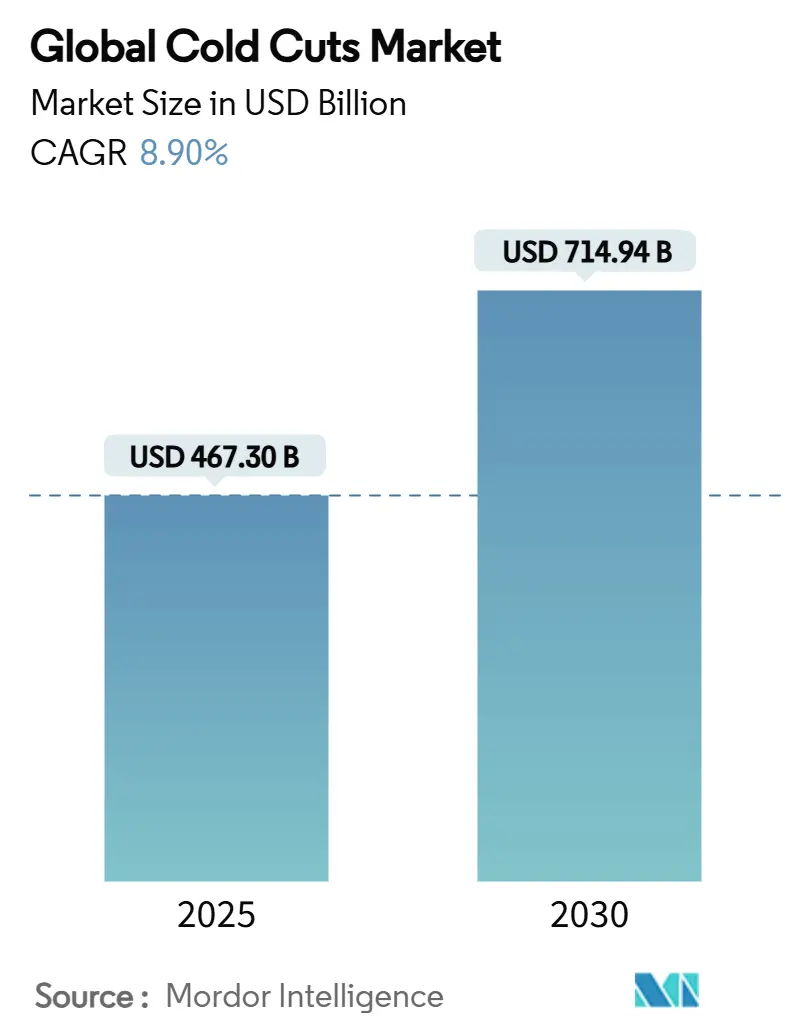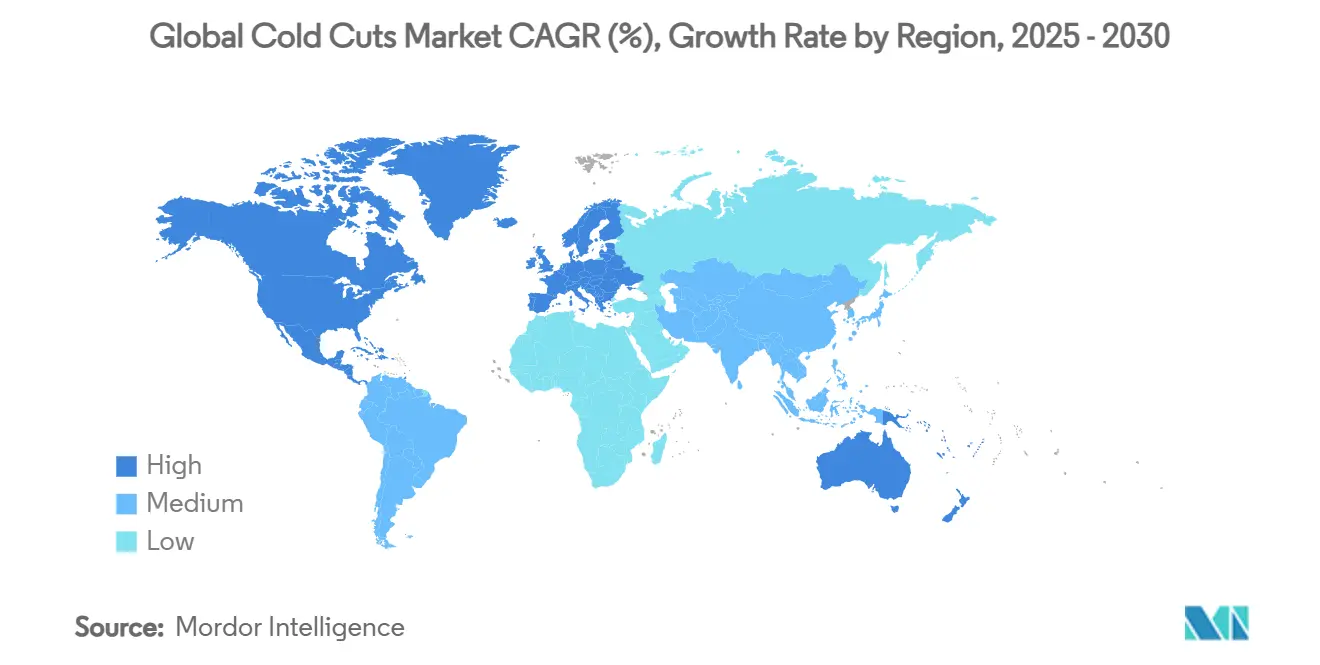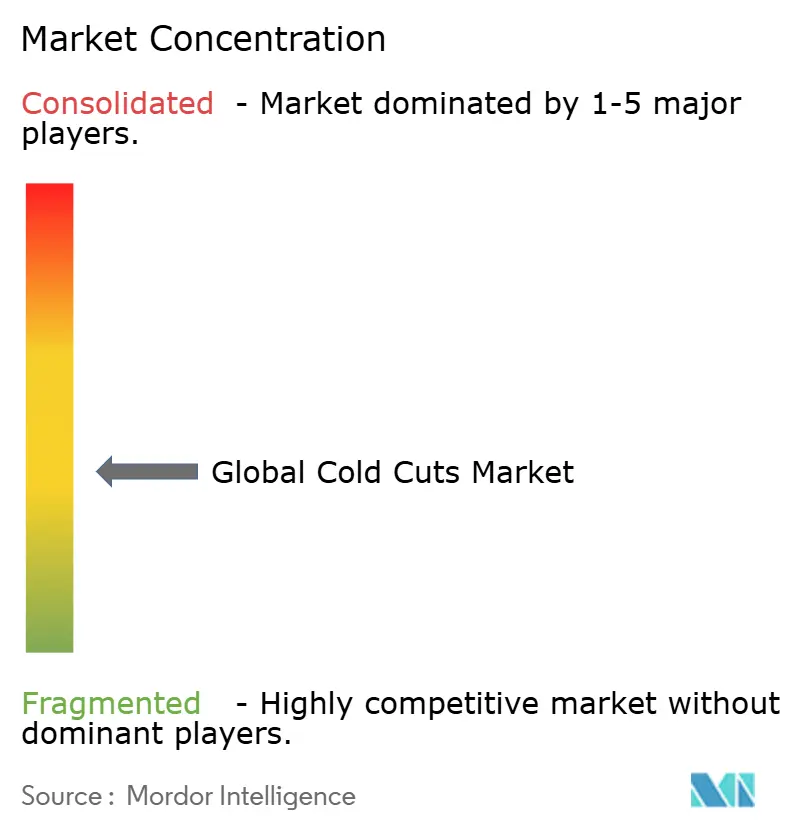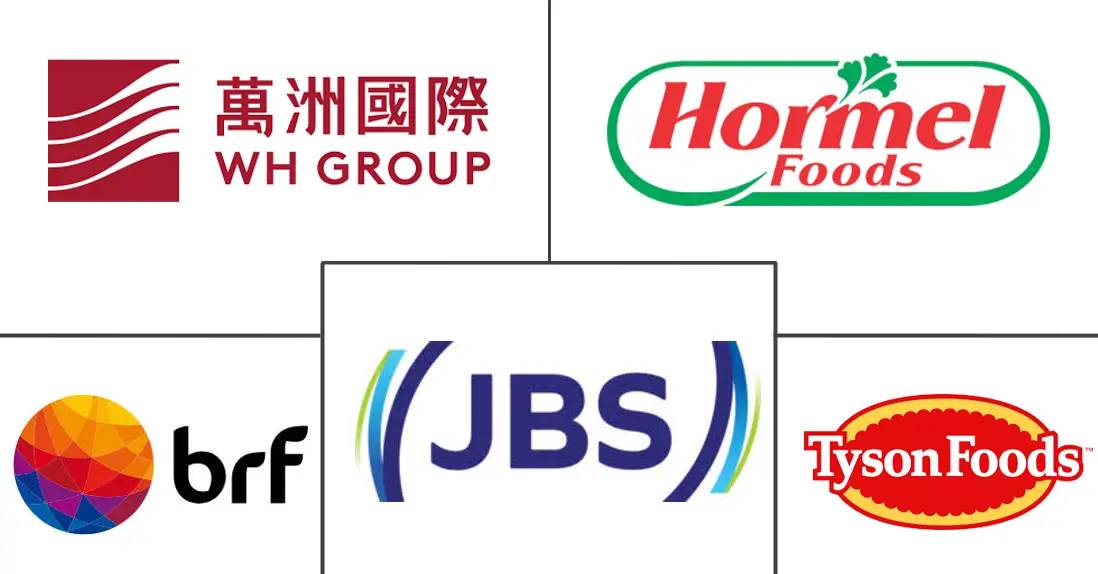Cold Cuts Market Size and Share

Cold Cuts Market Analysis by Mordor Intelligence
The cold cuts market size stood at USD 467.3 billion in 2025 and is forecast to advance to USD 714.94 billion by 2030, translating into an 8.9% CAGR over the period. Robust demand for convenient, protein-rich foods, accelerating urbanization, and continuous investment in preservation and packaging technology are underpinning this trajectory. According to the Organisation for Economic Co-operation and Development, in 2023, around 140 million tons of poultry meat were consumed worldwide, making it the most consumed type of meat globally[1]Source: US Department of Agriculture, "USDA Agricultural Projections to 2033" www.ers.usda.gov. Pork was the second most consumed meat worldwide, followed by beef and veal. Stronger purchasing power in developing economies, the shift toward on-the-go meal occasions, and the roll-out of stricter food-safety protocols are shaping competitive strategies. Large integrated producers are expanding capacity, while smaller artisanal labels rely on niche flavour innovation and clean-label messaging to secure shelf space. Regulatory moves that restrict nitrites, combined with consumer pressure for recyclable packs, are raising compliance costs yet simultaneously creating opportunities for suppliers able to deliver safe, sustainable, and premium-positioned products.
Key Report Takeaways
- By product type, poultry captured 41.6% of the cold cuts market share in 2024; beef and turkey are the only animal proteins forecast to record a faster than 9.2% CAGR through 2030.
- By form, sliced products commanded 43.91% share of the cold cuts market size in 2024 and are advancing at a 9.54% CAGR through 2030.
- By packaging, modified-atmosphere technology held 34.2% of the cold cuts market share in 2024, while recyclable formats are projected to expand at 10.92% CAGR to 2030.
- By channel, retail accounted for 59.2% share of the cold cuts market size in 2024; foodservice is the fastest-growing route, registering an 8.7% CAGR to 2030.
- By geography, North America led with 34.2% revenue share in 2024; Asia-Pacific is forecast to deliver the highest regional CAGR at 11.32% through 2030.
Global Cold Cuts Market Trends and Insights
Driver Impact Analysis
| Driver | (~) % Impact on CAGR Forecast | Geographic Relevance | Impact Timeline |
|---|---|---|---|
| Growing Demand for High-Protein Foods | +1.5% | Global, strongest in North America & Asia-Pacific | Long term (≥ 4 years) |
| Variety and Innovation in Product Offerings | +0.8% | North America & Europe, expanding to Asia-Pacific | Medium term (2-4 years) |
| Advancements in Packaging Technology | +1.2% | Global, led by Europe & North America | Medium term (2-4 years) |
| Rising Popularity of Snacking and On-the-Go Eating | +0.9% | Global, strongest in urban centers | Short term (≤ 2 years) |
| Growth of Foodservice and Catering Sectors | +1.1% | Asia-Pacific core, spill-over to MEA | Long term (≥ 4 years) |
| Sustainability and Ethical Sourcing Initiatives | +0.7% | Europe & North America, expanding globally | Long term (≥ 4 years) |
| Source: Mordor Intelligence | |||
Growing Demand for High-Protein Foods
The rising global interest in high‑protein diets is significantly reshaping the cold cuts market through 2024–2025, driving innovation, premiumization, and policy convergence around cleaner, more nutritious meat offerings. This trajectory is closely tied to consumer trends—particularly in urban centers—favoring convenient, ready‑to‑eat protein sources. Health‑minded shoppers increasingly select lean chicken and turkey variants, low‑fat, reduced-sodium, and clean‑label products, driving product diversification. On the high‑protein front, cold cuts are positioned as a portable protein boost, appealing to millennials, Gen Z, and working professionals who look for satisfying snacks or meal components that deliver on protein content and convenience. The trend is no longer confined to fitness enthusiasts; ageing consumers seek muscular maintenance, while younger cohorts pursue satiety within calorie-restricted diets. Producers now highlight 15–20 g protein per 2-ounce serving on pack fronts, reinforcing value perception. Asia-Pacific’s rising incomes amplify the effect, as traditional carbohydrate-heavy meals give way to animal-protein add-ons in urban centres. Together, these factors support sustained long-term demand and underpin the 8.9% overall CAGR.
Variety & Innovation in Product Offerings
Shifting consumer preferences are evident as they lean towards novel flavors, artisanal formats, and hybrid plant-meat blends. Convenient packaging, such as snack cups and trio-flavor packs, has become the go-to choice for snacking, charcuterie boards, and ready meals. In response, manufacturers are rolling out premium clean-label offerings—think nitrate-free, organic, and free from antibiotics and hormones. They're also infusing regional spices and adopting ethnic or gourmet profiles. The market is witnessing a surge in artisanal cures, fusion flavors, and a focus on certified-humane sourcing. Take North Country Smokehouse, for instance: their Certified Humane deli range boasts a 20–30% price premium over standard offerings. Limited-edition products, like truffle turkey and low-sodium pastrami, are carving out niche margins, particularly in North America and Europe, even when volume growth is tepid. Formulas that are clean-label and devoid of artificial nitrites are resonating with health-conscious consumers. At the same time, a strong export demand is driving recipe adaptations for Asian tastes, exemplified by the chilli-lime chicken ham. Furthermore, innovations in 2024–2025 have been both directly and indirectly supported by government and regulatory actions. A case in point: the USDA's $110 million investment in late 2024, aimed at modernizing the poultry and meat supply chain and automating processing, is paving the way for new packaging formats and product variants.
Advancements in Packaging Technology
Innovations like vacuum-sealing and modified atmosphere packaging (MAP) now routinely extend shelf life up to three times longer by minimizing oxygen exposure and retarding spoilage—especially critical for sliced deli meats—which reduces waste, enhances supply chain efficiency, and supports just‑in‑time retail models. Modified-atmosphere packs that double shelf life relative to standard flow-wrap, and high-pressure processing that eliminates pathogens without heat, remain the backbone of cold cuts' safety regimes. The next innovation wave centres on recyclable mono-material films and compostable cellulose trays that align with EU waste directives. Brand owners also pilot smart labels with freshness sensors and QR-based provenance data, supporting transparency demanded by clean-label consumers. Adoption is highest in Europe, yet cost efficiencies and legislative pressure are driving rapid take-up in North America and selected Asia-Pacific markets.
Sustainability & Ethical Sourcing Initiatives
Under the UK's "Meat in a Net Zero World" initiative, forty supply-chain partners are actively piloting greenhouse-gas reductions. They're emphasizing carbon-footprint disclosures on packaging and channeling investments into regenerative agriculture certifications. The trend of consumers willing to pay a premium for verified low-impact meats is expanding, moving from a niche group of natural-food enthusiasts to mainstream supermarket shoppers. Brands are bolstering their image with recyclable vacuum films and plant-based inks. Furthermore, integrated life-cycle assessments empower producers to gauge and benchmark their progress. In line with this movement, Tyson Foods made waves in 2024 by pouring investments into facilities focused on sustainable meat production. Their forward-thinking initiatives not only aim to elevate environmental standards within the supply chain but also champion green packaging and ethical meat processing. These efforts resonate with both consumer expectations and global industry benchmarks. The resulting reputational boost, coupled with advantages on retailer scorecards, is driving a tangible increase in market demand.
Restraints Impact Analysis
| Restraint | (~) % Impact on CAGR Forecast | Geographic Relevance | Impact Timeline |
|---|---|---|---|
| Rising Popularity of Plant-Based Diets | -0.6% | North America & Europe, expanding to Asia-Pacific | Medium term (2-4 years) |
| Stringent Food Safety Regulations | -0.4% | Global, strictest in North America & Europe | Short term (≤ 2 years) |
| Packaging Waste and Sustainability Concerns | -0.3% | Europe & North America, expanding globally | Long term (≥ 4 years) |
| Clean Label and Ingredient Transparency Demands | -0.2% | North America & Europe, emerging in Asia-Pacific | Medium term (2-4 years) |
| Source: Mordor Intelligence | |||
Rising Popularity of Plant-Based Diets
As dietary guidelines increasingly favor legumes, lentils, beans, and other plant proteins over red and processed meats, institutions like the U.S. Dietary Guidelines Advisory Committee are advocating for reduced processed meat consumption. They now prioritize plant-based proteins, relegating traditional cold cuts lower in the "protein foods" hierarchy. In response, plant-based producers have rolled out new cold-cut alternatives that closely mimic traditional deli slices. In May 2024, Tofurky launched its "Next Generation Plant-Based Deli Slices" in turkey and ham flavors, boasting 13 g of protein per serving. These slices are being marketed as direct, healthier replacements for conventional cold cuts, especially targeting foodservice menus. Meanwhile, in Switzerland, food-tech startup Planted introduced its pea-protein-based "cleanest Lyoner cold cut" through Coop. They tout a texture and taste akin to the animal version, all while significantly reducing CO₂ emissions and water usage compared to traditional sausage production. These moves underscore a significant shift in consumer preferences, steering them away from processed meat formats like cold cuts.
Packaging Waste & Sustainability Concerns
As public scrutiny intensifies on single-use plastics, legacy multilayer films, commonly used in vacuum and MAP formats, find themselves under pressure. In response, policymakers in the EU and certain U.S. states have introduced extended producer responsibility schemes. These schemes elevate disposal fees, steering manufacturers towards pricier recyclable alternatives. Europe's December 2024 Council regulation on packaging waste sets forth binding reuse targets, curbs single-use plastics, and mandates specific percentages of recyclable materials in packaging by 2030–2040. Meanwhile, in the U.S., states like Oregon, Minnesota, Maryland, and New Jersey have rolled out EPR schemes. These require producers to register, report packaging data, utilize recyclable materials, and phase out polystyrene by the middle of 2025–26. Although green packaging can fetch a premium on shelves, the shift to such solutions introduces added complexity and costs for manufacturers.
Segment Analysis
By Product Type: Poultry Dominance Drives Market Evolution
Poultry-based lines held 41.6% of the cold cuts market share in 2024 and are projected to grow at a 9.2% CAGR through 2030, driving segment expansion. Their demand stems from price competitiveness, lean nutrition, and versatility. Chicken breast, ham, and smoked turkey pastrami align with consumer preferences for lower saturated fats and high protein. The US Department of Agriculture reported U.S. poultry consumption at 116 pounds per capita in 2023[2]Source: US Department of Agriculture, "Meat consumption", www.oecd.org. Turkey sales spike during holidays, boosting annual averages.
Pork remains relevant in culturally entrenched hams and salamis, while beef holds premium status in delicatessen SKUs. Veal, lamb, and game cater to niche luxury markets. Poultry’s share continues to grow due to favorable feed-conversion economics and shorter production cycles, attracting cost-sensitive households in developing regions. Producers invest in antibiotic-free and cage-free poultry chains to meet ethical standards and enhance brand credibility. Vertical integration ensures traceability during audits, while air-chilling systems improve yield and support cleaner label claims. These factors reinforce poultry’s dominance in the cold cuts market while maintaining profitability.

Note: Segment shares of all individual segments available upon report purchase
By Form: Sliced Convenience Meets Processing Innovation
Sliced presentations captured 43.91% of the cold cuts market size in 2024 and are projected to register 9.54% CAGR through 2030. Single-serve packs, resealable tubs, and easy-peel trays resonate with smaller households and snack-focused consumers. Innovations in blade technology minimise oxidative discolouration, extending chill case life and maintaining appetising visual cues. Barcode traceability on outer film offers instant sourcing data, reinforcing quality perceptions. The sliced format also dominates grab-and-go merchandising in supermarket delis, reinforcing brand visibility at the point of sale.
Whole-muscle items such as boneless hams and mortadella logs cater to delicatessens and hospitality buffets, supplying flexibility in cut thickness and portion customization. This sub-segment experiences slower value growth yet remains important for traditional festive dishes and banquet catering. Ground or processed emulsions (bologna, luncheon meats) occupy value-tier positions, appealing to cost-conscious buyers in emerging economies. Recent reformulation efforts lower sodium and introduce fibre-rich extenders, meeting nutrition guidelines without compromising flavour. Altogether, form diversification allows processors to serve multiple consumer missions, buttressing overall cold cuts market growth.

Note: Segment shares of all individual segments available upon report purchase
By Packaging Technology: Sustainability Transforms Traditional Approaches
Modified-atmosphere packaging led with 34.2% cold cuts market share in 2024, delivering shelf-life gains up to 100% over conventional wraps and preserving colour vibrancy, attractive to shoppers. Producers refine gas blends to limit purge and maintain low residual oxygen, mitigating lipid oxidation. Despite MAP’s dominance, sustainable mono-material pouches and fibre-based trays are charting the fastest rise with a 10.92% CAGR, propelled by retailer plastics pledges and escalating landfill levies in several European jurisdictions. For premium charcuterie, vacuum skin packs deliver artisanal appearance while cutting drip loss, enabling zero-waste claims. Digital watermarking embedded in pack substrates helps sorters automate recycling streams, boosting end-of-life recoverability.
Cost differentials between legacy multilayer and next-gen recyclable films still hover at 10–20%, but as petrochemical inputs remain volatile, the gap is narrowing. Plant-based sealants derived from sugar-cane ethanol or cellulose further decarbonise the footprint. Overall, packaging technology now operates as a brand differentiator as much as a functional container, reshaping investment priorities across the cold cuts market.

Note: Segment shares of all individual segments available upon report purchase
By Distribution Channel: Retail Dominance Faces Foodservice Growth
Retail outlets garnered 59.2% of the cold cuts market size in 2024, spanning supermarkets, hypermarkets, convenience stores, and fast-growing pure-play e-commerce. The global rise in the number of supermarkets and hypermarkets bolsters this segment's growth. For example, on March 1, 2025, the UK boasted 1,454 Sainsbury's grocery stores[3]Source: J Sainsbury Annual report, "J Sainsbury plc Annual Report 2025", www.about.sainsburys.co.uk. Multiples leverage private-label deli meats for trip generation, often positioning house brands adjacent to national SKUs to promote value perception. Online grocery, though still a single-digit share, grew triple digits in major urban centres as fulfilment networks scale refrigerated last-mile capabilities. Subscription snack boxes featuring premium salumi and artisan cheeses further broaden direct-to-consumer avenues.
Foodservice demand posts the sharpest acceleration at 8.7% CAGR to 2030, benchmarking against the rapid expansion of QSR breakfast menus and corporate catering across Asia-Pacific. Cold cuts serve as labor-saving building blocks for sandwiches, salad bars, and pizza toppings. Suppliers collaborate with chain operators to establish customized slice thickness, power-pack formats, and extended holding performance under hot lamps without moisture loss. Parallel HoReCa (hotel, restaurant, and café) growth in Middle East tourism corridors and Latin American quick-lunch segments unlocks additional volume avenues. Consequently, channel diversification reinforces overall cold cuts market growth resilience.

Geography Analysis
In 2024, North America contributed 34.2% of global revenue, driven by a strong sandwich culture, extensive refrigerated retail infrastructure, and demand for premium products like nitrate-free and humanely raised options. Compliance with updated USDA-FSIS Listeria guidelines is boosting investments in high-pressure processing and environmental monitoring. Tyson Foods' USD 355 million bacon facility in Kentucky highlights ongoing investments in value-added meats. Premium pricing offsets slight declines in per-capita volume, sustaining low-single-digit CAGR growth.
Asia-Pacific, with an 11.32% CAGR, leads incremental volume growth. China dominates tonnage, but South and Southeast Asia see the fastest growth as middle-class consumers adopt Western-style breakfast meats and convenience foods. Urbanization drives demand for packaged sliced ham and chicken loaf, while foodservice chains standardize turkey breast portions. Reduced duties on chilled meats within ASEAN strengthen supply chains and support capacity expansion by multinational processors.
Europe, a mature market, is shaped by artisanal traditions and regulatory changes. Stricter EU nitrite caps are driving shifts to natural curing agents, fostering R&D collaborations. Sustainability initiatives like WRAP's net-zero roadmap push trials of compostable trays in UK supermarkets. Consolidation continues, with GranTerre's acquisition of Parmacotto targeting EUR 1.5 billion turnover in five years.

Competitive Landscape
The cold cuts industry exhibits moderate concentration as the top five processors control roughly 45–50% of global value sales. Integrated giants Tyson Foods, Hormel, JBS, BRF, and Maple Leaf leverage captive feed mills, slaughter, processing, and distribution networks to secure raw-material stability and cost advantages. Capital intensity and regulatory compliance hurdles deter smaller newcomers, yet artisan charcuterie startups thrive in localised premium niches. Strategic moves underscore the competitive dynamic:
Tyson Foods opened a high-throughput bacon facility capable of 2 million lbs weekly to meet retail breakfast demand. JBS tabled an acquisition bid for Saudi Arabia’s Al Watania, strengthening halal reach. Maple Leaf spun off its pork business, freeing resources to accelerate value-added poultry and deli diversification.
Technology adoption is pivotal. Firms roll out high-pressure processing to secure pathogen reduction, modified-atmosphere lines to lengthen shelf life for export, and blockchain-style traceability to document animal-welfare standards. Sustainability narratives are now mainstream: carbon-neutral chicken ham SKUs and recyclable mono-material packs command premium shelf prices, creating price-to-earnings uplifts despite higher input costs. Competition from plant-based challengers remains a headline risk; in response, incumbents have added hybrid char-crust turkey-pea protein slices to portfolios, safeguarding consumer choice and share of stomach.
Cold Cuts Industry Leaders
-
Tyson Foods Inc.
-
WH Group (Smithfield Foods)
-
Hormel Foods Corp.
-
BRF S.A.
-
JBS S.A.
- *Disclaimer: Major Players sorted in no particular order

Recent Industry Developments
- July 2025: Columbus Craft Meats, a Hormel Foods brand, expanded its deli meat portfolio by introducing its first standalone uncured pepperoni product. This launch responded directly to consumer demand for premium, versatile deli options and reinforces Hormel’s competitive positioning in the premium deli sector with a clean-label, additive-free offering.
- January 2025: Brooklyn Cured launched new Cocktail-Inspired Salami flavors—Dirty Martini Salami and pork-free Tuscan Red Wine Beef Salami—while expanding national store placements for its Snack Packs and refreshing its online presence. This demonstrated the company’s focus on flavor innovation, dietary inclusivity (pork-free), and strengthening brand visibility both in retail and digital channels.
- October 2024: Maple Leaf Foods launched the “Maple Leaf 50/50” cold cuts line, blending meat with plant-based proteins and natural ingredients, catering to consumers seeking both traditional and plant-forward proteins.
Global Cold Cuts Market Report Scope
| Pork |
| Beef |
| Poultry |
| Turkey |
| Veal |
| Other Meats |
| Sliced Cold Cuts |
| Whole Cold Cuts |
| Ground or Processed Cold Cuts |
| Vacuum-Sealed |
| Modified Atmosphere Packaging |
| Plastic Containers/Trays |
| Sustainable/Recyclable Packaging |
| Foodservice/HoReCa (Hotel/Restaurant/Catering) | |
| Retail | Supermarkets/Hypermarkets |
| Specialty Stores | |
| Online Retail Stores | |
| Other Distribution Channels |
| North America | United States |
| Canada | |
| Mexico | |
| Rest of North America | |
| South America | Brazil |
| Argentina | |
| Colombia | |
| Chile | |
| Rest of South America | |
| Europe | United Kingdom |
| Germany | |
| France | |
| Italy | |
| Spain | |
| Russia | |
| Sweden | |
| Belgium | |
| Poland | |
| Netherlands | |
| Rest of Europe | |
| Asia-Pacific | China |
| Japan | |
| India | |
| Thailand | |
| Singapore | |
| Indonesia | |
| South Korea | |
| Australia | |
| New Zealand | |
| Rest of Asia-Pacific | |
| Middle East and Africa | United Arab Emirates |
| South Africa | |
| Saudi Arabia | |
| Egypt | |
| Morocco | |
| Turkey | |
| Rest of Middle East and Africa |
| By Product Type | Pork | |
| Beef | ||
| Poultry | ||
| Turkey | ||
| Veal | ||
| Other Meats | ||
| By Form | Sliced Cold Cuts | |
| Whole Cold Cuts | ||
| Ground or Processed Cold Cuts | ||
| By Packaging Technology | Vacuum-Sealed | |
| Modified Atmosphere Packaging | ||
| Plastic Containers/Trays | ||
| Sustainable/Recyclable Packaging | ||
| By Distribution Channel | Foodservice/HoReCa (Hotel/Restaurant/Catering) | |
| Retail | Supermarkets/Hypermarkets | |
| Specialty Stores | ||
| Online Retail Stores | ||
| Other Distribution Channels | ||
| By Geography | North America | United States |
| Canada | ||
| Mexico | ||
| Rest of North America | ||
| South America | Brazil | |
| Argentina | ||
| Colombia | ||
| Chile | ||
| Rest of South America | ||
| Europe | United Kingdom | |
| Germany | ||
| France | ||
| Italy | ||
| Spain | ||
| Russia | ||
| Sweden | ||
| Belgium | ||
| Poland | ||
| Netherlands | ||
| Rest of Europe | ||
| Asia-Pacific | China | |
| Japan | ||
| India | ||
| Thailand | ||
| Singapore | ||
| Indonesia | ||
| South Korea | ||
| Australia | ||
| New Zealand | ||
| Rest of Asia-Pacific | ||
| Middle East and Africa | United Arab Emirates | |
| South Africa | ||
| Saudi Arabia | ||
| Egypt | ||
| Morocco | ||
| Turkey | ||
| Rest of Middle East and Africa | ||
Key Questions Answered in the Report
What is the current cold cuts market size and projected growth?
The cold cuts market size reached USD 467.3 billion in 2025 and is forecast to climb to USD 714.94 billion by 2030 at an 8.9% CAGR.
Which protein segment leads the cold cuts market?
Poultry dominates with 41.6% market share in 2024 and is projected to expand at 9.2% CAGR through 2030, outperforming pork and beef.
Why are sliced cold cuts growing so quickly?
Portion-controlled sliced packs fit on-the-go consumption patterns, command shelf visibility and benefit from improved slicing and packaging technology, yielding a 9.54% CAGR forecast.
How are sustainability pressures affecting packaging?
Retailer pledges and new waste regulations are accelerating adoption of recyclable mono-material films, pushing sustainable packaging to a 10.92% CAGR despite higher unit costs.
What regions present the strongest growth opportunities?
Asia-Pacific is set to post an 11.32% CAGR, propelled by urbanisation, rising incomes and rapid foodservice expansion, notably in China, India and Southeast Asia.
Page last updated on:



